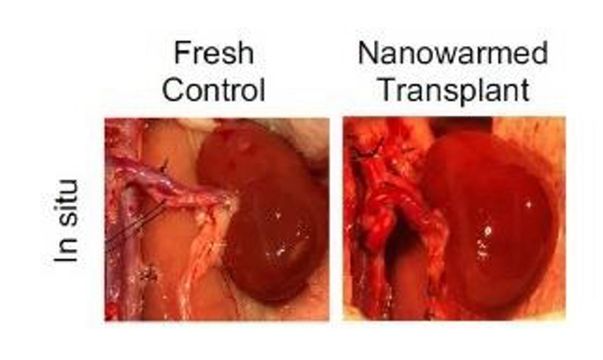ERC Researchers Transplant Rewarmed Rat Kidneys After 100-Day Cold Storage
Outcome/Accomplishment
The NSF-funded Engineering Research Center (ERC) for Advanced Technologies for the Preservation of Biological Systems (ATP-Bio), co-led by the University of Minnesota and Massachusetts General Hospital, demonstrated that rat kidneys preserved at ultra-low temperatures can be warmed with an innovative procedure and recover full function after being transplanted into rat recipients.
Impact/Benefits
Roughly 20% of kidneys donated for transplants each year don’t reach recipients in time to get transplanted. Kidneys are kept on ice, where they last only a few hours, because longer-lasting cryopreservation techniques typically lead to damaging ice formation and cracking upon rewarming. The ability to store organs longer could make access to organs more reliable and more equitable.
Explanation/Background
Researchers from the University of Minnesota’s Bischof Lab (mechanical engineering), Finger Lab (surgery), and other collaborators developed a procedure that rapidly cooled and rewarmed rat kidneys to avoid ice damage. Called nanowarming, the process begins by infusing kidneys with antifreeze-like chemicals and iron oxide nanoparticles. Then, the scientists rapidly cool the kidneys until they reach a glass-like state. To thaw the kidneys, they apply a radiofrequency field that causes the nanoparticles to radiate heat, which warms the kidney uniformly. After washing away the chemicals and nanoparticles, the kidney is ready to be transplanted.
The procedure worked with kidneys cryopreserved for up to 100 days. Rat recipients regained full kidney function within 30 days. The researchers say the procedure can scale to bigger organs and may one day be applicable to many different organs. They plan to apply their approach to pig kidneys next.
Location
Minneapolis, Minnesotawebsite
Start Year
Biotechnology and Healthcare
Biotechnology and Healthcare
Lead Institution
Core Partners
Fact Sheet
Outcome/Accomplishment
The NSF-funded Engineering Research Center (ERC) for Advanced Technologies for the Preservation of Biological Systems (ATP-Bio), co-led by the University of Minnesota and Massachusetts General Hospital, demonstrated that rat kidneys preserved at ultra-low temperatures can be warmed with an innovative procedure and recover full function after being transplanted into rat recipients.
Location
Minneapolis, Minnesotawebsite
Start Year
Biotechnology and Healthcare
Biotechnology and Healthcare
Lead Institution
Core Partners
Fact Sheet
Impact/benefits
Roughly 20% of kidneys donated for transplants each year don’t reach recipients in time to get transplanted. Kidneys are kept on ice, where they last only a few hours, because longer-lasting cryopreservation techniques typically lead to damaging ice formation and cracking upon rewarming. The ability to store organs longer could make access to organs more reliable and more equitable.
Explanation/Background
Researchers from the University of Minnesota’s Bischof Lab (mechanical engineering), Finger Lab (surgery), and other collaborators developed a procedure that rapidly cooled and rewarmed rat kidneys to avoid ice damage. Called nanowarming, the process begins by infusing kidneys with antifreeze-like chemicals and iron oxide nanoparticles. Then, the scientists rapidly cool the kidneys until they reach a glass-like state. To thaw the kidneys, they apply a radiofrequency field that causes the nanoparticles to radiate heat, which warms the kidney uniformly. After washing away the chemicals and nanoparticles, the kidney is ready to be transplanted.
The procedure worked with kidneys cryopreserved for up to 100 days. Rat recipients regained full kidney function within 30 days. The researchers say the procedure can scale to bigger organs and may one day be applicable to many different organs. They plan to apply their approach to pig kidneys next.

